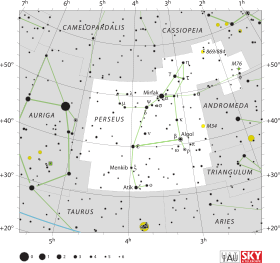Nova Persei 2018
 | |
| Observation data Epoch J2000.0 Equinox J2000.0 | |
|---|---|
| Constellation | Perseus |
| Right ascension | 04h 43m 21.37s[1] |
| Declination | +47° 21′ 25.9″[1] |
| Apparent magnitude (V) | 6.3 - 16.9[2] |
| Characteristics | |
| B−V color index | +1.0[3] |
| V−R color index | +0.9[3] |
| Variable type | dwarf nova & nova[1] |
| Astrometry | |
| Proper motion (μ) | RA: 0.193[4] mas/yr Dec.: −1.749[4] mas/yr |
| Parallax (π) | 0.2573 ± 0.0516[4] mas |
| Distance | approx. 13,000 ly (approx. 3,900 pc) |
| Absolute magnitude (MV) | −10.1 (max)[5] |
| Other designations | |
| Database references | |
| SIMBAD | data |
Nova Persei 2018 is a bright nova in the constellation Perseus discovered on April 29, 2018. It was previously known as a dwarf nova with variable star designation V392 Persei.
Dwarf nova
A U Geminorum-type variable star or dwarf nova is a type of cataclysmic variable star consisting of a close binary star system in which one of the components is a white dwarf that accretes matter from a cool main sequence or subgiant companion.[6] V392 Persei was discovered in 1970 and received its variable star designation a year later. It is normally visual magnitude 17.4 and experiences outbursts of 2-3 magnitudes.[1] Its spectrum in the quiescent state has been studied and only the cool star is detected. The spectrum shows emission lines of hydrogen-alpha (Hα) and both neutral and ionised helium.[3] The brightest recorded observations is at magnitude 5.6.[5]
Nova eruption
On April 29, 2018 it was discovered by Yuji Nakamura to be extremely bright, and it was spectroscopically confirmed as a nova outburst with magnitude 6.2 on April 30. The spectrum includes broad Hα and FeII emission lines with P Cygni profiles. The absorption core is blueshifted by a velocity of 2,680 km/s, which would be the expansion velocity from the nova explosion.[7]
Observations with Fermi-LAT on April 30 show a strong gamma-ray source at the coordinates of the nova.[8] Photometry of the nova from Konkoly Observatory on May 1, 2018 give apparent magnitudes of 7.38 in the V band and 8.22 in the B band, suggesting it is already declining.[9]
System
V392 Persei is the southern of a pair of stars separated by 8.5".[2]
The symbiotic pair are unresolved and the nature of the cool component is unclear. The spectral energy distribution is inconsistent with a bright giant star but it could be less luminous red clump giant or subgiant. If the cool component was a main sequence red dwarf as expected for a dwarf nova, then the system would need to be closer than the 13,000 ly suggested by its Gaia parallax.[5]
Gallery
 Dwarf nova V392 Persei over the ESO Supernova Planetarium & Visitor Centre.[10]
Dwarf nova V392 Persei over the ESO Supernova Planetarium & Visitor Centre.[10] V392 Persei, 2 May 2018, 22:00 UT. The slightly fainter nearby star is 9th magnitude BD+47°1026. Up is approximately east.
V392 Persei, 2 May 2018, 22:00 UT. The slightly fainter nearby star is 9th magnitude BD+47°1026. Up is approximately east.
See also
References
- 1 2 3 4 Samus, N. N.; Durlevich, O. V.; et al. (2009). "VizieR Online Data Catalog: General Catalogue of Variable Stars (Samus+ 2007-2013)". VizieR On-line Data Catalog: B/gcvs. Originally published in: 2009yCat....102025S. 1. Bibcode:2009yCat....102025S.
- 1 2 Watson, C. L. (2006). "The International Variable Star Index (VSX)". The Society for Astronomical Sciences 25th Annual Symposium on Telescope Science. Held May 23–25. 25: 47. Bibcode:2006SASS...25...47W.
- 1 2 3 Liu, Wu; Hu, J. Y (2000). "Spectroscopic Confirmation of Northern and Equatorial Cataclysmic Variables. III. 32 Poorly Known Objects". The Astrophysical Journal Supplement Series. 128: 387. Bibcode:2000ApJS..128..387L. doi:10.1086/313380.
- 1 2 3 Brown, A. G. A.; et al. (Gaia collaboration) (August 2018). "Gaia Data Release 2: Summary of the contents and survey properties". Astronomy & Astrophysics. 616. A1. arXiv:1804.09365. Bibcode:2018A&A...616A...1G. doi:10.1051/0004-6361/201833051.
- 1 2 3 Darnley, M. J; Starrfield, S (2018). "On the Progenitor System of V392 Persei". Research Notes of the AAS. 2 (2): 24. arXiv:1805.00994. Bibcode:2018RNAAS...2b..24D. doi:10.3847/2515-5172/aac26c.
- ↑ N.N. Samus; O.V. Durlevich (February 12, 2009). "GCVS Variability Types and Distribution Statistics of Designated Variable Stars According to their Types of Variability". Retrieved 2013-02-08.
- ↑ R. M. Wagner; D. Terndrup; M. J. Darnley; S. Starrfield; C. E. Woodward; M. Henze. "Optical Spectroscopy of TCP J04432130+4721280 (V392 Per) Confirms a Nova Eruption". Retrieved 2018-05-02.
- ↑ Kwan-Lok Li; Laura Chomiuk; Jay Strader. "Bright gamma-ray emission from TCP J04432130+4721280 (V392 Per) detected by Fermi-LAT". Retrieved 2018-05-02.
- ↑ R. Konyves-Toth; B. Csak; A. Pal; J. Vinko. "Optical Photometry of the Nova Outburst TCP J04432130+4721280 (V392 Per)". Retrieved 2018-05-02.
- ↑ "Nova over Supernova". www.eso.org. Retrieved 7 May 2018.
External links
- Dwarf Nova V392 Persei Goes Big — It’s Now Binocular Bright
- How A Dwarf Nova Hit The Big Time May 2, 2018
- Nova in Perseus
- V392 Per in outburst, showing spectra of the nova in outburst and previously
.png)